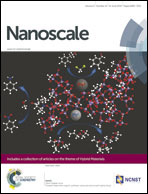Mn0.5Co0.5Fe2O4 nanoparticles highly dispersed in porous carbon microspheres as high performance anode materials in Li-ion batteries
Abstract
We report the preparation of Mn0.5Co0.5Fe2O4 (MCFO) nanoparticles highly dispersed within porous carbon microspheres as anodes for Li-ion batteries. In situ growth of MCFO nanoparticles (5–20 nm) on the surface of carbon black (CB) and graphitized carbon black (GCB) nanoparticles was conducted via a hydrothermal method to form MCFO–CB and MCFO–GCB composites, respectively, which were employed as building blocks to assemble MCFO–CB and MCFO–GCB porous microspheres (PM) with a size of 5–30 μm by the spray drying technique using sucrose as a binder, and followed by carbonization in N2 (labeled as MCFO–CB-PM and MCFO–GCB-PM, respectively). Compared with the pure MCFO, MCFO–CB, and MCFO–GCB, both MCFO–CB-PM and MCFO–GCB-PM showed a significantly improved electrochemical performance. This is attributed to their unique porous structure, in which, the abundant pores promote the diffusion of Li-ion and electrolyte solution, the microspherical morphology enhances the electrode–electrolyte contact, and the carbon substrates from CB (and GCB) and sucrose substantially prevent the aggregation of MCFO nanoparticles and buffer the volume change. Particularly, MCFO–GCB-PM exhibits the best rate performance and excellent cycling stability because of the high graphitization degree of GCB. This work opens up an effective route for large scale fabrication of metal oxide/carbon porous microspheres as anode materials for potential applications in the new generation of Li-ion batteries.


 Please wait while we load your content...
Please wait while we load your content...